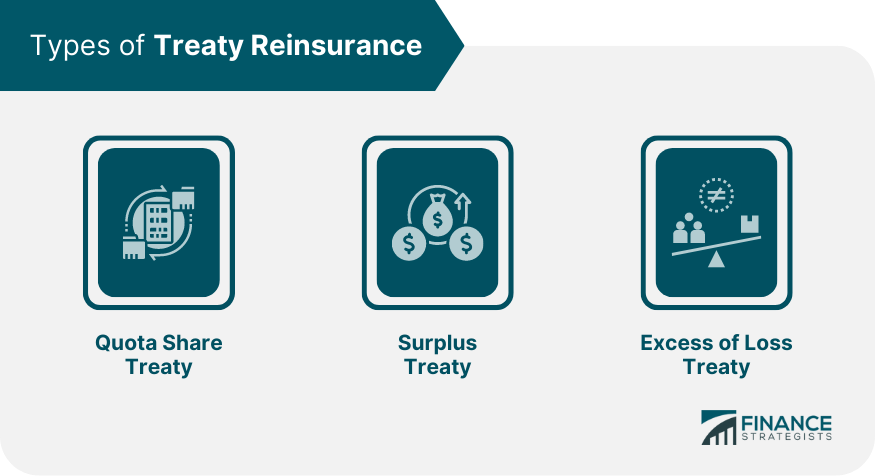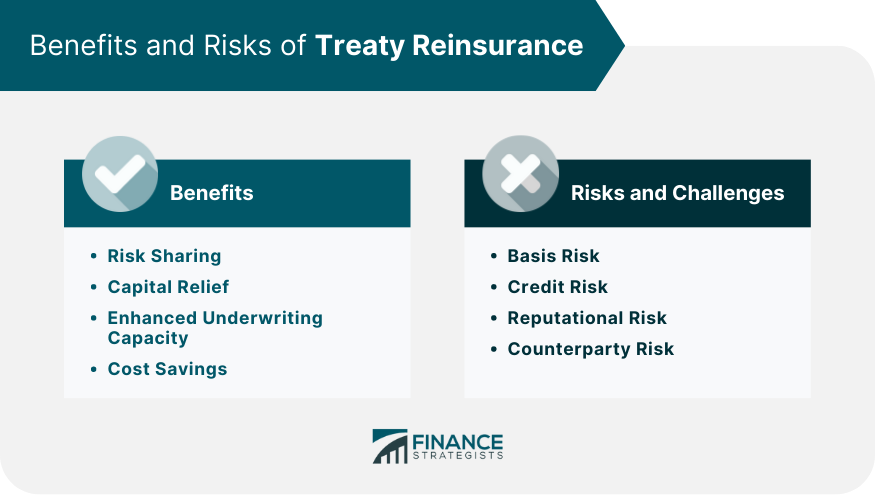Treaty reinsurance is a type of reinsurance arrangement in which an insurer, known as the ceding company, transfers a specified portion of its risk exposure to a reinsurer under a pre-agreed contract. The reinsurer, in turn, agrees to indemnify the ceding company for a portion of its losses stemming from the covered risks. This arrangement allows the ceding company to reduce its overall risk exposure, while the reinsurer earns premiums in exchange for assuming the transferred risk. Treaty reinsurance plays a crucial role in the financial industry by promoting stability and risk-sharing among insurers. By allowing insurers to transfer a portion of their risk exposure to reinsurers, treaty reinsurance helps insurers maintain their solvency, even in the face of large or unexpected losses. This increased stability enhances the overall resilience of the insurance market and helps ensure that policyholders are protected in the event of a major catastrophe or other significant loss event. In a treaty reinsurance arrangement, the ceding company and the reinsurer enter into a contract that outlines the specific terms and conditions of the risk transfer. This contract, known as a reinsurance treaty, specifies the types of risks covered, the portion of risk transferred, the premiums payable to the reinsurer, and the limits of the reinsurer's liability. Once the treaty is in place, the ceding company automatically cedes a portion of its risk exposure to the reinsurer, as per the agreed-upon terms. Reinsurance premiums are the payments made by the ceding company to the reinsurer in exchange for the risk transfer. The premiums are typically calculated as a percentage of the ceding company's gross written premiums for the covered risks. The reinsurance treaty will also specify the limits of the reinsurer's liability, which represent the maximum amount the reinsurer will pay for losses under the treaty. These limits may be expressed on a per-event basis, an aggregate basis, or a combination of both. The relationship between the ceding company and the reinsurer in a treaty reinsurance arrangement is based on trust and long-term partnership. Both parties must work together to ensure accurate risk assessment, pricing, and claims management. The ceding company relies on the reinsurer to provide financial support and risk expertise, while the reinsurer relies on the ceding company to underwrite and manage the covered risks effectively. A quota share treaty is a type of treaty reinsurance in which the ceding company and the reinsurer agree to share a fixed percentage of the premiums and losses for the covered risks. This arrangement provides the ceding company with proportional risk-sharing and capital relief, as the reinsurer assumes a portion of both the premium income and the losses. In return, the reinsurer earns a share of the ceding company's premiums. A surplus treaty is another form of treaty reinsurance in which the ceding company retains a predetermined amount of risk, known as the retention, and transfers the excess risk to the reinsurer. The reinsurer's liability is limited to the amount of risk exceeding the ceding company's retention. This type of treaty allows the ceding company to maintain a higher level of risk retention while still benefiting from the risk-sharing and capital relief provided by the reinsurer. An excess of loss treaty is a type of treaty reinsurance that provides coverage for losses exceeding a specified threshold, known as the attachment point. The reinsurer indemnifies the ceding company for losses above the attachment point, up to a specified limit. This type of treaty is designed to protect the ceding company from catastrophic losses or other large, unexpected loss events. Unlike quota share and surplus treaties, excess of loss treaties do not involve the sharing of premiums or proportional risk-sharing between the ceding company and the reinsurer. One of the primary benefits of treaty reinsurance is risk sharing. By transferring a portion of its risk exposure to a reinsurer, the ceding company can reduce its overall risk concentration and protect itself from large or unexpected losses. This risk-sharing arrangement enhances the stability of the insurance market and ensures that policyholders are adequately protected. Treaty reinsurance provides capital relief for the ceding company by allowing it to free up capital that would otherwise be tied up in maintaining reserves for the transferred risks. This capital can be redeployed to support other business activities, such as underwriting new risks or expanding into new markets, potentially improving the company's overall financial performance. By transferring a portion of its risk exposure to a reinsurer, the ceding company can increase its underwriting capacity, allowing it to write more policies and take on additional risks without increasing its overall risk concentration. This can lead to increased revenue and profitability for the insurer while maintaining an appropriate level of risk. Treaty reinsurance can result in cost savings for the ceding company by reducing the administrative and operational costs associated with managing individual risks. By pooling risks under a single treaty, the ceding company can streamline its risk management processes, leading to greater efficiency and cost savings. Basis risk is the potential for the reinsurance treaty to not adequately cover the ceding company's risk exposure due to differences between the actual losses and the losses covered under the treaty. This risk can arise from factors such as policy exclusions, misaligned risk profiles, or inaccurate pricing models. The ceding company and the reinsurer must work together to minimize basis risk and ensure that the treaty provides appropriate coverage. Credit risk refers to the risk that the reinsurer may become financially unable or unwilling to fulfill its obligations under the reinsurance treaty. This can occur due to factors such as financial distress, regulatory actions, or other adverse events. The ceding company must carefully assess the creditworthiness of its reinsurer and monitor its financial strength to manage credit risk effectively. Reputational risk is the potential for the ceding company's reputation to be negatively impacted by its association with the reinsurer, particularly in cases where the reinsurer has faced regulatory or legal issues or has a history of poor financial performance. To manage reputational risk, the ceding company should carefully evaluate the reinsurer's track record and ensure that it maintains a strong reputation in the industry. Counterparty risk is the risk that the reinsurer may not fulfill its obligations under the treaty reinsurance arrangement due to factors such as insolvency, fraud, or disputes between the ceding company and the reinsurer. To manage counterparty risk, the ceding company should perform thorough due diligence on the reinsurer, establish clear communication channels, and monitor the reinsurer's performance throughout the life of the treaty. Treaty reinsurance is an important risk management tool that enables insurers to transfer a portion of their risk exposure to reinsurers under a pre-agreed contract. The arrangement provides numerous benefits, such as risk-sharing, capital relief, enhanced underwriting capacity, and cost savings. However, it also comes with risks and challenges, such as basis risk, credit risk, reputational risk, and counterparty risk, which must be carefully managed by both the ceding company and the reinsurer. There are various types of treaty reinsurance, including quota share treaties, surplus treaties, and excess of loss treaties, each with its unique risk-sharing characteristics and purposes. Insurers must carefully consider their risk management needs and objectives when selecting the most suitable type of treaty reinsurance for their business. In conclusion, treaty reinsurance plays a vital role in the financial industry by promoting stability and risk-sharing among insurers. By understanding how treaty reinsurance works, the different types of treaty reinsurance, and the associated benefits and risks, insurers can make informed decisions about their reinsurance strategies and ensure that they maintain appropriate levels of risk and capital.What Is Treaty Reinsurance?
How Treaty Reinsurance Works
Treaty Reinsurance Arrangement
Reinsurance Premiums and Limits
Ceding Company and Reinsurer Relationship
Types of Treaty Reinsurance
Quota Share Treaty
Surplus Treaty
Excess of Loss Treaty

Benefits of Treaty Reinsurance
Risk Sharing
Capital Relief
Enhanced Underwriting Capacity
Cost Savings
Risks and Challenges of Treaty Reinsurance
Basis Risk
Credit Risk
Reputational Risk
Counterparty Risk

Final Thoughts
Treaty Reinsurance FAQs
Treaty Reinsurance is a type of reinsurance that involves the transfer of risks from an insurer to a reinsurer through a contractual agreement.
The three main types of Treaty Reinsurance are Quota Share Treaty, Surplus Treaty, and Excess of Loss Treaty.
Treaty Reinsurance can provide benefits such as risk sharing, capital relief, enhanced underwriting capacity, and cost savings for ceding companies.
Some of the risks and challenges of Treaty Reinsurance include basis risk, credit risk, reputational risk, and counterparty risk.
Treaty Reinsurance works by a ceding company transferring a portion of its insurance risks to a reinsurer through a treaty agreement, in exchange for a reinsurance premium.
True Tamplin is a published author, public speaker, CEO of UpDigital, and founder of Finance Strategists.
True is a Certified Educator in Personal Finance (CEPF®), author of The Handy Financial Ratios Guide, a member of the Society for Advancing Business Editing and Writing, contributes to his financial education site, Finance Strategists, and has spoken to various financial communities such as the CFA Institute, as well as university students like his Alma mater, Biola University, where he received a bachelor of science in business and data analytics.
To learn more about True, visit his personal website or view his author profiles on Amazon, Nasdaq and Forbes.











